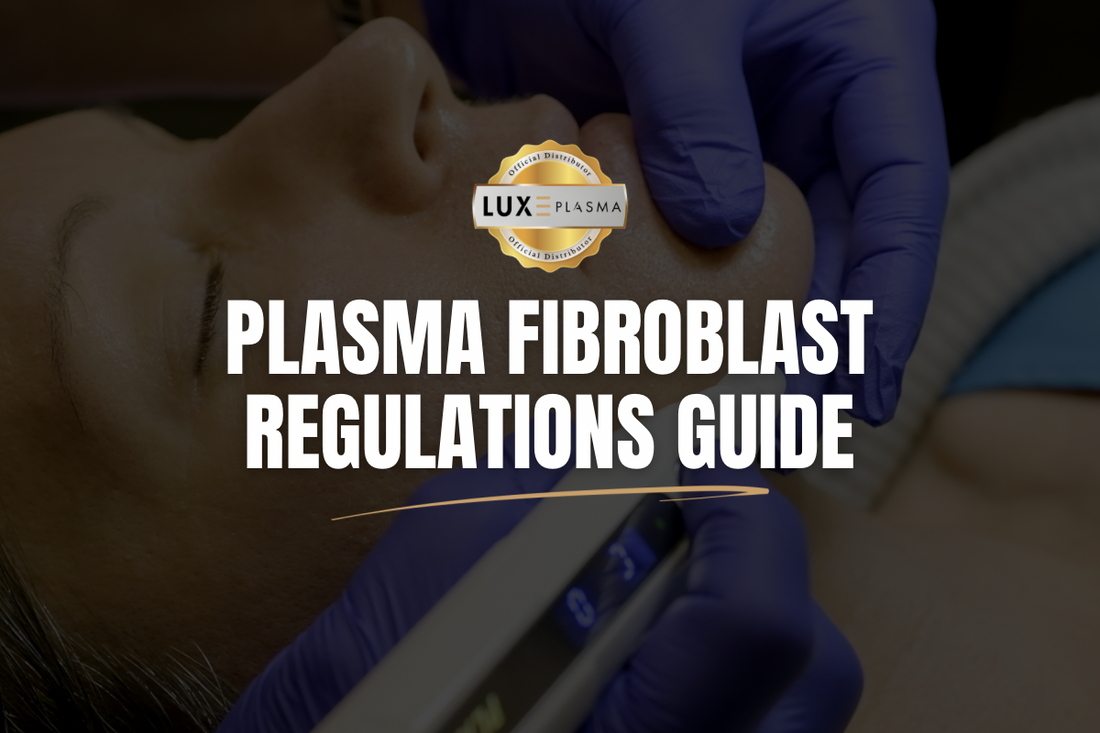
What qualifications do you need to offer plasma fibroblast?
Share
How to Legally Offer Plasma Treatments as an esthetic professional:
If you’re wondering, “What qualifications do I need to offer plasma treatments?”, you’re not alone and this is a very common question we’re asked by those looking to offer this treatment. Plasma pen treatments remain in a regulatory “gray area,” and the rules vary across states. Some states have strict regulations, while others have little oversight.
This guide will help you navigate plasma regulations by answering:
- What qualifications do I need to offer plasma treatments?
- Who should I contact to check if I can legally perform these treatments?
- What terminology should I use when speaking to state officials?
- What are creative ways to legally offer plasma treatments in strict states?
⚠️ Disclaimer: We are not legal professionals, and this is not legal advice. You must verify compliance with your state regulatory board before offering plasma treatments.
Step 1: Contacting Your State Officials the Right Way
Your state’s regulatory board (such as the Board of Cosmetology, Health Department, or Licensing Board) is the best place to check for compliance. If you hold an esthetician license, tattoo license, body art permit, or PMU certification, reach out to the issuing authority to see what is allowed under your credentials.
💡 Pro Tip: DO NOT use the term “plasma fibroblast.”
Many officials associate this term with electric pens that burn the skin, which have caused scarring, hyperpigmentation, and adverse reactions. This stigma can instantly trigger a negative response from regulators.
Instead, position the treatment correctly by using terms like:
- ✔️Plasma Energy Facial
- ✔️Collagen Induction Therapy
- ✔️PlasmaChanneling
- ✔️ Collagen Stimulation Therapy
Some estheticians also compare LUXE/PLAXEL+ Plasma to a high-frequency device like the Skin Classic machine, which helps officials better understand its non-invasive nature.
Step 2: Explaining Plasma Energy Correctly
When discussing the treatment with state regulators, keep it simple and only provide the information requested to avoid misunderstandings.
✅ How to correctly describe Plasma Energy Facials to regulators:
The LUXE Plasma Pen (Formerly PLAXEL plasma Pen) delivers true plasma energy into the epidermis without puncturing the skin. It helps reduce the appearance of sagging skin, fine lines, and wrinkles by sublimating dead skin cells. The plasma energy does not treat the dermis, and the needle tip never touches the skin.
The micro-injury to the skin’s surface is so minimal that it can be considered a form of exfoliation. The white dots created during treatment occur due to the sublimation of dead skin cells, which is essentially an advanced exfoliation process rather than an invasive procedure.
🚫 What NOT to say to regulators or in your marketing:
- ❌ Do NOT claim that plasma treats medical conditions
- ❌ Do NOT describe it as a “fibroblast treatment”
- ❌ Do NOT mention “burning” or “ablating” the skin
💡 Important:
- If you’re using LUXE/PLAXEL+ PlasmaChanneling, ball or cold plasma tips, you are not causing micro-injury At All To The Skin —you’re only massaging the skin with plasma energy, which does not require healing time and is generally not a concern for state boards.
- However, we suggest that needle tips (True Plasma Probes) be stored separately, this way you can show an inspector the massaging capabilities of the device and avoid showing them the True Plasma Probes to avoid them confusing this with commonly used electric pens.
Step 3: What If Your State Is Too Strict?
If your state makes it difficult to offer plasma treatments, consider alternative legal options:
✅ 1. Get a Medical Director
A Medical Director can provide oversight, allowing you to legally offer plasma treatments under medical supervision.
If you need help finding one, Kevin Jallat from Coroderm can help. Visit https://www.corpoderm.us/contact and contact them for more details.
✅ 2. Get a Tattoo or Body Art Permit
Many estheticians choose to separate plasma services from their esthetic license by obtaining a tattoo or body art permit. In some states, estheticians face strict regulations, but tattoo professionals may not require a Medical Director.
💡 Tip: If an inspector visits, you can show them LUXE/PLAXEL+ PlasmaChanneling, cold plasma, hair rejuvenation, or ball tips, which are non-invasive massage tools. This avoids unnecessary scrutiny as mentioned earlier in this post.
✅ 3. Set Up Separate Treatment Rooms
If you hold both an esthetician license and a tattoo/body art/PMU permit, consider using:
- One room for esthetics (licensed treatments)
- One room for tattoo/body art services (plasma treatments)
✅ 4. Post an “Unregulated Services” Disclaimer
Some states allow businesses to offer experimental treatments if they clearly state they are unregulated. You might be able to post a notice explaining that:
Plasma energy treatments are intended to reduce the appearance of fine lines, wrinkles, and sagging skin but are not yet regulated by the FDA.
⚠️ Check with your state board before posting any disclaimers!
Final Thoughts
Navigating plasma regulations can be challenging, but you CAN legally offer these services with the right approach.
- ✔️ Avoid medical claims
- ✔️ Use correct terminology (Plasma Lift, Plasma Energy, etc.)
- ✔️ Check with your state board for compliance
- ✔️ Consider alternative licensing options if needed
We cover all the legal nuances in our official online training, “Legalities for Estheticians”, so you can confidently offer plasma treatments without breaking any rules.
Need Help? Contact Us!
📲 Text us at (469) 620-7188
🌐 Order the LUXE/PLAXEL Plasma Pen and our official training and certification program at www.luxeplasma.com
